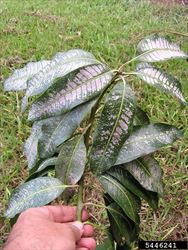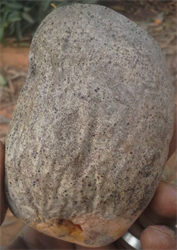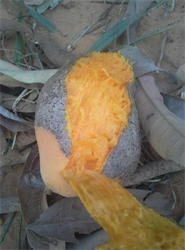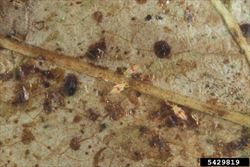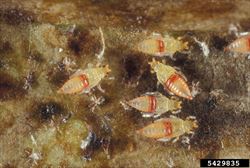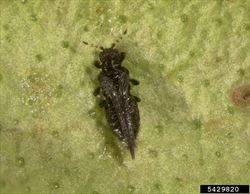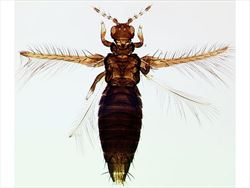- Widespread. Major pest of tropical fruit crops: avocado. Canarium. cashew, guava, mango. mangosteen, rambutan, and more.
- Adult and nymph mouthparts break cells and suck up juices and surface layers turn silvery. Black spots of solidified excreta form where thrips feed, with excess falling on leaves below stimulating growth of sooty moulds. Leaves fall; symptoms on fruit impact sales.
- Eggs, laid without fertilisation on underside of leaves, hatch within 4 days producing creamy-yellow nymphs with two red bands around the middle, and red tipped abdomens. After two non-feeding (pupal) stages adults emerge, 1mm long, with feathery wings. Males rare.
- Spread: on the wind; thrips are poor flyers. Long distance associated with trade of fruit and nursery stock.
- Biosecurity: risk fron imported fruit and nursery stock.
- Biocontrol: natural predators - lacewings, predatory thrips, predatory bugs, weaver ants, Oecophylla sp. (see Fact Sheet nos. 86, 270, 386, 406). Egg parasitoid, Goetheana shakespearei, collected in Indonesia, introduced into Africa, the Caribbean, Hawaii.
- Cultural control: windbreaks around orchards; ensure healthy growth – spacing, nutrition, irrigation, pruning; avoid planting near alternative hosts. Monitor: (i) blue or yellow sticky traps; (ii) tap foliage over white trays or cloth.
- Chemical control: avoid broad-spectrum insecticides: (i) use aggregate pheromone, plus insecticide; (ii) use neem – either commercial product or homemade (see Fact Sheet no. 402); (iv) petroleum oils; (v) biological insecticides - Metarhizum anisopliae, Beauveria bassiana, abamectin.
Pacific Pests, Pathogens and Weeds - Online edition
Pacific Pests, Pathogens, Weeds & Pesticides
Red-banded thrips (519)
Red-banded thrips. It is also known as the cocoa thrips.
Selenothrips rubrocinctus; previously, it was known as Heliothripss rubrocinctus, and Physopus rubriocinctus.
AUTHORS Grahame Jackson
Information from CABI (2021) Selenothrips rubrocincitus (red-banded thrips). Crop Protection Compendium. (https://www.cabi.org/cpc/datasheet/50265); Brown H, Chin D (2013) Red-banded thrips on fruit trees (Selenothrips rubrocinctus). Agnote 134. (https://industry.nt.gov.au/__data/assets/pdf_file/0019/233614/719.pdf); Denmark HA, et al. (2016) Redbanded thrips Selenothrips rubroconctus. Featured Creatures. Florida Department of Agriculture and Consumer Services, and University of Florida. (https://entnemdept.ufl.edu/creatures/orn/thrips/redbanded_thrips.htm); and CABI (2018) Red-banded thrips on cashew Selenothrips rubrocinctus. Plantwise Knowledge Bank. (https://www.plantwise.org/KnowledgeBank/pmdg/20187800833); and from Dennill GB, Erasmus MJ (1992) Basis for a practical technique for monitoring thrips in avocado orchards. Crop Protection, 11(1):89-91. Photo 1 Scot Nelson, University of Hawaii at Manoa, Budwood.org (https://www.forestryimages.org/browse/detail.cfm?imgnum=5446241). Photos 2&3 Pierre Silvie Identification of fruit mango problems. PestNet. (https://app.pestnet.org/submissions/view?submissionId=303c1957-4906-4aa2-832a-49586c38a26f). Photos 4-6 Lyle Buss, University of Florida, Bugwood.org. (https://www.forestryimages.org/browse/detail.cfm?imgnum=5429819, https://www.forestryimages.org/browse/detail.cfm?imgnum=5429835) and (https://www.forestryimages.org/browse/detail.cfm?imgnum=5429820). Photo 7 Mound L (2005) Red-banded Cocoa Thrips (Selenothrips rubrocinctus). PaDIL - http://www.padil.gov.au.
Produced with support from the Australian Centre for International Agricultural Research under project HORT/2016/185: Responding to emerging pest and disease threats to horticulture in the Pacific islands, implemented by the University of Queensland, in association with the Pacific Community.
